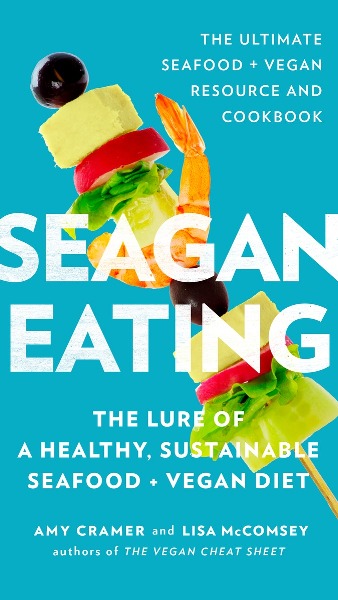
Adapted from SEAGAN EATING: The Lure of a Healthy, Sustainable Seafood + Vegan Diet by Amy Cramer and Lisa McComsey. © 2016 by Amy Cramer and Lisa McComsey. TarcherPerigee, an imprint of Penguin Random House LLC.
*Editor’s Note: Here at elephant, we’re notorious bookworms—we love them, and want you to love them, too. But, recently, we found out books are evil—one of the worst things for the environment. Before you buy your next book, read this and this. Keep reading, but read responsibly.
So what exactly do seagans eat?
We follow a vegan (plant-based) diet—that includes fruits, vegetables, legumes, nuts, seeds, and grains—with one allowance: seafood. No red meat, no pork, no poultry, no eggs, no dairy. And because we strive to be healthy seagans, we try to avoid a lot of sugar, oils, fried foods, artificial chemicals, and junk like that. (The operative word is strive. We’re not perfect.)
There are arguments for and against just about any diet you can think of, and it’s easy enough to hear what you want to hear (we’re praying that the hot-fudge sundae will one day be declared a superfood).
It all boils down to this: Choose what works for you. We believe seaganism is an incredibly healthful, easy, and satisfying way to eat.
So let’s start with why we ditched dairy and meat and limit our oil intake.
Bye-Bye Meat, Dairy, and Eggs
So long, Amy’s veal Milanese. Good riddance, cheesy omelets. It was nice knowing you, ice cream. I’ll never meet a smoother snack than you, Greek yogurt. Ah, breaking up is hard to do. But like many breakups, it can open the door to healthier relationships.
Our decision to go splitsville with these admittedly delicious foods was not a capricious one. No one in her right mind parts ways with Ben & Jerry’s Peanut Butter Half Baked without a damn good reason. Or several. Here are ours:
Americans’ waistlines are expanding, with more than a third of adults now classified as “obese” and two-thirds as “overweight or obese.” Childhood obesity is on the rise, too.
We’re a sick nation. Despite our access to one of the most advanced health-care systems in the world, we suffer from ever-increasing rates of chronic ailments and life-threatening illnesses, like heart disease, diabetes, cancer, and Alzheimer’s.
We are what we eat—and if what we eat is high in fat, sugar, and other disease-promoting muck, we’ll likely pay the price. (Hello, doctors, hospitals, and meds.) Cleaning up our plates is one of the simplest and most profound ways we can take better care of ourselves on a day-to-day basis. By decreasing our consumption of the nasty stuff—and boosting our intake of whole, nutritionally dense, plant-based foods and the occasional slab of omega-3-rich seafood—we’ll enjoy a spike in health, energy, and maybe even longevity.
Doing away with foods rich in saturated fats (meats and dairy) and introducing those brimming in omega-3s (seafood) is part of our plan.
As it turns out, the government agrees. A 2015 report issued by the Dietary Guidelines Advisory Committee found that the American diet is “suboptimal and has major adverse health consequences”; it is “low in vegetables, fruit, and whole grains and high in sodium, calories, saturated fat, refined grains, and added sugars.”
Their recommendation? A largely plant-based diet “higher in vegetables, fruits, whole grains, seafood, legumes, and nuts…and low in sugar-sweetened foods and drinks and refined grains.”
A later 2015 report by the World Health Organization determined that consuming processed meats like hot dogs, ham, and bacon increases the risk of colon cancer and that eating red meats—including beef, veal, pork, and lamb—may heighten the risk as well.
Meat Packs a Nasty Environmental Punch
Raising livestock for meat exerts a huge toll on the environment. The industry has an unquenchable thirst for land, water, and other precious resources, and pollutes like crazy: More than half the global greenhouse-gas emissions come from, yes, flatulent cows and pigs; plus, untreated animal waste makes its ways into rivers and streams.
Speaking of water, it takes 850 gallons of H20 to produce an 8-ounce portion of beef and 330 gallons for 6 ounces of pork. By comparison, an 8-ounce serving of kale “drinks” just 18 gallons.
Meat production also goes against the grain: About 13 pounds of the stuff is needed for just 1 pound of beef. That means more than half the world’s crops are grown to feed livestock—not humans.
Oil, We Love You, But…
You’ve heard the news: Certain vegetable oils are good for your heart. Right? Well, like many claims in the food world, there’s some controversy surrounding the oils-are-healthy assertion.
Detractors believe that oil—while plant based—is not a whole food, since its nutrients and fiber have been squeezed out. What’s left is just a fat- and calorie-dense liquid that merely serves to pack on the pounds and clog arteries. (Better option: Eat the olives, not the olive oil; the sesame seeds, not the sesame-seed oil; the coconut, not the coconut oil. You get the idea.)
While all that’s debatable and we haven’t sworn off oil completely, we’ve learned to use it sparingly. For example, you don’t need oil for sautéing—a dry pan with a touch of water or other liquid works beautifully. Oils in baked-good recipes have suitable replacements, like applesauce. Salad dressings can be made without oils and still taste rich and delicious.
Our collection of oil-free recipes gives you plenty of proof. You’ll save hundreds of calories and likely won’t taste the difference.
So next time you reach for that bottle of oil, ask yourself: Do I really need it? Do I really want it? Will I even taste the difference? Instead of dousing your food in that caloric, high-fat olive or coconut oil, you may just want to slather it on your skin and hair—they make wonderful natural moisturizers!
What’s with all the fish hubbub? And why should I get hooked?
Fish is the perfect package: low in fat, high in protein, and overflowing with vitamins, minerals, and that thing we really love (and loves us back)—omega-3 fatty acids.
Here’s the scoop. Omega-3s are essential fatty acids. Our bodies don’t produce them, so we have to get them from the foods we eat.
And by the way, they’re not called “essential” for nothing. These mighty little acids are workhorses—you might even call them miracle workers—crucial to healthy cell growth, proper fetal development, and robust immune functions. They’re also critical for strong organs—including eyes, heart, and brain—and tissues.
Deprive yourself and pay the price: Omega-3 deficiencies have been linked to all sorts of health issues, including heart attacks, mood swings, circulatory problems, arthritis, macular degeneration, autoimmune diseases, attention-deficit disorder, allergies, asthma, and skin conditions.
Need more convincing?
Consuming omega-3s may help prevent and treat certain cancers, depression, dementia, Parkinson’s disease, high blood pressure, high LDL (“bad”) cholesterol, diabetes, allergies—and the list goes on.
A Love Affair with Limits
High omega-3 content isn’t the Holy Grail if it comes from tainted sources. Some fish—especially the large ones, like swordfish, king mackerel, and albacore tuna—contain high levels of mercury and should be avoided.
Others are suffering from low populations, habitat destruction, and bycatch issues (fish and other marine creatures that are unintentionally captured while fishing for target species) and need to be left alone. Make wise, thoughtful choices—our Good Catch, Bad Catch guide will help light the way.
Authors: Amy Cramer & Lisa McComsey
Image: Courtesy of Author
Editors: Catherine Monkman; Emily Bartran











Read 0 comments and reply